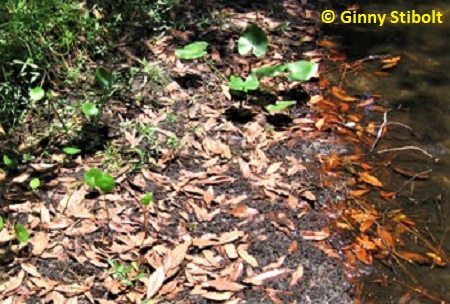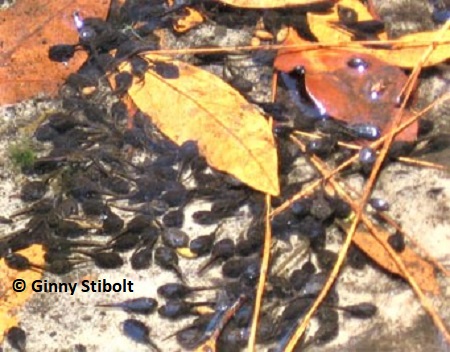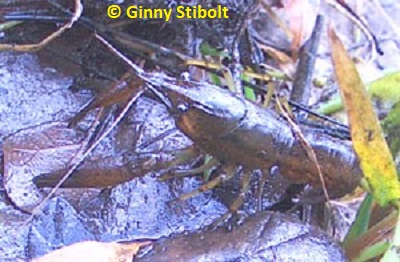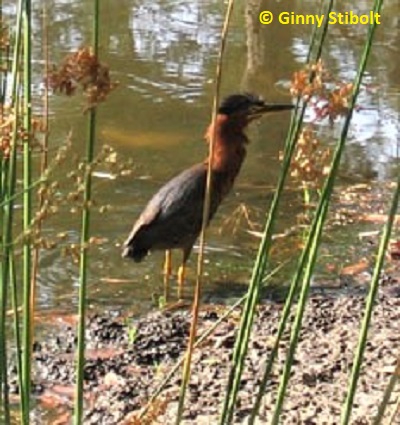Adventures of a Transplanted Gardener |
||||
Pond
pleasures
| ||||
|
|
A natural pond graces our front yard. It's a long oval measuring approximately 45' x 120' and is about 5' deep in the middle. It's teaming with life from snapping turtles, cooter turtles, bass, blue gills, sunfish, crayfish, and tadpoles to the albino catfish and multicolored koi that our pond-sharing neighbors added. Then green herons, great blue herons, American egrets, kingfishers, and, once in a while, anhingas fish for their dinners in our pond. The pond is a continuing source of pleasure—there's always something interesting in it or around its shores.
(Update: As of 2021, there is only one koi left. All th other introduced fish are gone.)
Time for dry-season pond maintenance
We thought the pond might be spring-fed because there are so many springs around our Lake Asbury neighborhood. During this very dry period at the end of May, the pond level receded so much, that we've concluded that if there's a spring, it's very weak. It's probably a groundwater pond.
 |
<< The pond's shoreline is exposed so the leaves from overhanging trees were easy to rake. Most of the spring leaves are from the evergreen red bay (Persea borbonia) tree that drops last year's leaves each spring. There's always something dropping here in Florida.
(Update: the red bay was attacked by the ambrosia beetle and died two year later. See Red Bay Trees are Dying.)
The shade trees help keep the water cool, but their leaves settle to the bottom and add to the muck. Too much muck can enrich the water so the algae grow too much. This pond doesn't have a severe algal problem such as what turned the St. Johns River green last year*. Taking out some of the muck keeps the algal blooms at bay and the whole ecosystem a little healthier.
This is a natural pond with no stream flowing into it so there are few sources of external nutrients. We don't fertilize our lawn and we've created a buffer zone of native plants around the edge. The groundwater could possibly be nutrient-rich from neighbors' lawn practices, but probably not. We pump water from Lake Asbury at the back of our lot to run our sprinkler system. When the sprinklers are running, we turn on an extra sprinkler into the pond to help aerate the pond water and to help maintain its depth. The lake water could be a source of extra nutrients.
Periodically we've gathered moldering leaves and associated muck from the pond. I've used pond muck in the bottom of planting holes to enrich our sandy soil and to retain moisture for the newly transplanted plants. This is the first time it's been easy to harvest. With the shallow areas high and almost dry, the leaves and other detritus were easy to scoop up. I raked slowly with the iron rake so the critters hiding under the leaves had a chance to scurry or swim away. I added this muck to the compost pile that I'll be reworking in the next couple of weeks. My spring planting has used up almost all the compost I made in February from all those water hyacinths (Eichhornia crassipes).
 |
Tadpoles love the shallow beach
Hundreds of black tadpoles crowded into the shallow waters of the pond. Large fish eyed them hungrily, but the tadpoles stayed together and weren't going any deeper. The water's surface vibrated with all their activity until the green heron, shown above, patrolled the beach. I watched it eat some of the tadpoles, before I chased it away. I don't normally interfere in Mother Nature's scheme, but I want lots of tadpoles to make it into their adult frog or toad stage. They eat so many bugs. I watched for tadpoles along the shore the next few days, but I didn't find nearly as many. They probably became someone else's dinner.
It's important to have several shallow areas along the shoreline of a pond. They provide relatively safe cover for the minnows and tadpoles and also provide easy access for turtles and squirrels. Birds and butterflies use shallow and damp beach areas to bathe and get a drink.
 |
A crawdad surprise
Earlier this spring I was surprised when I uncovered a crayfish (also known as crawdad or crawdaddy) in the leaves at the pond's edge. This is probably a red swamp crayfish (Procambarus clarkii) that's native to this area, but has become invasive in Europe. The common name, crayfish or crawfish, doesn't come from the word "fish", but it's derived from the word crevice, where they hide.
Crayfish are bottom feeders and eat dead animals and decaying plants. They stir up the muck and release trapped gases. I'm happy to have these critters in the pond and they will not end up in a jambalaya where so many of their relatives have met their fate.
A pond is an important feature for green space, backyard habitat, and plant and animal diversity. It's also a never-ending source of interesting backyard adventures. I hope you have a pond that you, your family, and your wildlife can enjoy.
*The nutrient cycle
The nutrient cycle for a natural pond, lake, or slow moving river starts with the plants (either simple, one-celled algae to more advance multi-celled flowering plants such as eel grass) and their ability to photosynthesize. This process uses carbon dioxide (CO2) and water (H2O) with energy from sunlight to form sugar (C6H12O6) and oxygen gas (O2). During photosynthesis oxygen dissolves in the water and is then available to aquatic plants, animals, and bacteria that all require it for respiration. Respiration is the opposite chemical reaction, where plants and animals take in oxygen and break down sugar to get energy for life and release water and carbon dioxide.
Animals eat plants and other animals and produce waste products as they live and die. The waste products and dead plants and animals sink to the bottom of the body of water. This muck, called detritus, breaks down with the help of bacteria and bottom feeders to produce nutrients. The more nutrients there are and the more available they become, the faster the plants, especially the algae, grow. This may be okay during the day when they can photosynthesize to produce enough oxygen to support the larger biomass of plants and animals, but not at night when no oxygen is being produced. When the biomass is too large for the dissolved oxygen supply, plants and animals die. As their bodies decompose, there is a surge of more bacterial activity and even more oxygen is required. Nothing can live in these waters—they are called dead zones.
Ginny Stibolt is a life-long gardener, a botanist, a naturalist, and a garden writer. You may contact her or read more of her articles posted on her website: www.greengardeningmatters.com.
Copyright Ginny Stibolt


